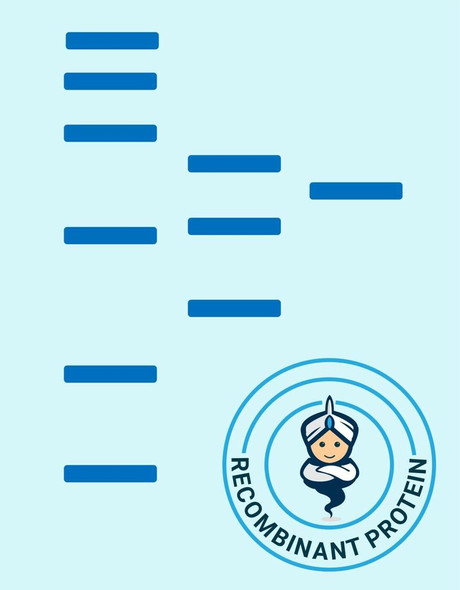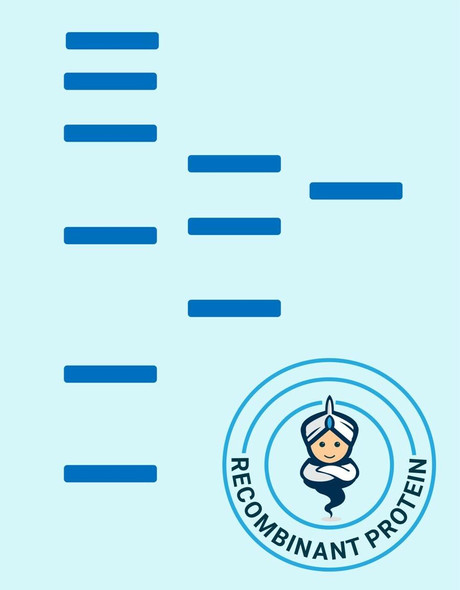Enzymes Recombinant Proteins
Human NDUFS4 Recombinant Protein (RPPB2013)
- SKU:
- RPPB2013
- Product Type:
- Recombinant Protein
- Species:
- Human
- Uniprot:
- O43181
- Research Area:
- Enzymes
Description
| Product Name: | Human NDUFS4 Recombinant Protein |
| Product Code: | RPPB2013 |
| Size: | 25µg |
| Species: | Human |
| Target: | NDUFS4 |
| Synonyms: | AQDQ, NDUFS4, NADH dehydrogenase [ubiquinone] iron-sulfur protein 4 mitochondrial, NADH-ubiquinone oxidoreductase 18 kDa subunit, Complex I-18 kDa, CI-18 kDa, Complex I-AQDQ, CI-AQDQ. |
| Source: | Escherichia Coli |
| Physical Appearance: | Sterile Filtered colorless solution. |
| Formulation: | The NDUFS4 solution contains 20mM Tris pH-8 & 30% glycerol. |
| Stability: | Store at 4°C if entire vial will be used within 2-4 weeks. Store, frozen at -20°C for longer periods of time.�For long term storage it is recommended to add a carrier protein (0.1% HSA or BSA).Please prevent freeze-thaw cycles. |
| Purity: | Greater than 90.0% as determined by SDS-PAGE. |
| Amino Acid Sequence: | MAQDQTQDTQ LITVDEKLDI TTLTGVPEEH IKTRKVRIFV PARNNMQSGV NNTKKWKMEF DTRERWENPL MGWASTADPL SNMVLTFSTK EDAVSFAEKN GWSYDIEERK VPKPKSKSYG ANFSWNKRTR VSTK |
NDUFS4 is a subunit of the mitochondrial membrane respiratory chain NADH dehydrogenase (Complex I), the primary multi-subunit enzyme complex of the mitochondrial respiratory chain. Complex I is involved in cellular ATP production, the main source of energy for numerous vital processes in living cells. NDUFS4 removes electrons from NADH and passes them by a series of diverse protein-coupled redox centers to the electron acceptor ubiquinone. NDUFS4 presents a hotspot of mutations in the genetic apparatus of oxidative phosphorylation and the correct assembly of the subunit it encodes is essential for completion of the assembly of complex I.
NDUFS4 Human Recombinant produced in E.Coli is a single, non-glycosylated, polypeptide chain containing 134 amino acids (43-175 a.a.) and having a molecular mass of 15.5 kDa.The NDUFS4 is purified by proprietary chromatographic techniques.
| UniProt Protein Function: | NDUFS4: Accessory subunit of the mitochondrial membrane respiratory chain NADH dehydrogenase (Complex I), that is believed not to be involved in catalysis. Complex I functions in the transfer of electrons from NADH to the respiratory chain. The immediate electron acceptor for the enzyme is believed to be ubiquinone. Defects in NDUFS4 are a cause of mitochondrial complex I deficiency (MT-C1D). A disorder of the mitochondrial respiratory chain that causes a wide range of clinical disorders, from lethal neonatal disease to adult-onset neurodegenerative disorders. Phenotypes include macrocephaly with progressive leukodystrophy, non-specific encephalopathy, cardiomyopathy, myopathy, liver disease, Leigh syndrome, Leber hereditary optic neuropathy, and some forms of Parkinson disease. Belongs to the complex I NDUFS4 subunit family. |
| UniProt Protein Details: | Protein type:EC 1.6.99.3; Oxidoreductase; EC 1.6.5.3; Mitochondrial; Energy Metabolism - oxidative phosphorylation Chromosomal Location of Human Ortholog: 5q11.1 Cellular Component: mitochondrion; mitochondrial inner membrane; mitochondrial respiratory chain complex I Molecular Function:NADH dehydrogenase (ubiquinone) activity Biological Process: mitochondrial respiratory chain complex I assembly; cellular metabolic process; regulation of protein amino acid phosphorylation; cAMP-mediated signaling; positive regulation of fibroblast proliferation; response to cAMP; mitochondrial electron transport, NADH to ubiquinone; cellular respiration; brain development Disease: Leigh Syndrome; Mitochondrial Complex I Deficiency |
| NCBI Summary: | This gene encodes an accessory subunit of the mitochondrial membrane respiratory chain NADH dehydrogenase (Complex I), or NADH:ubiquinone oxidoreductase, the first multi-subunit enzyme complex of the mitochondrial respiratory chain. Complex I plays a vital role in cellular ATP production, the primary source of energy for many crucial processes in living cells. It removes electrons from NADH and passes them by a series of different protein-coupled redox centers to the electron acceptor ubiquinone. In well-coupled mitochondria, the electron flux leads to ATP generation via the building of a proton gradient across the inner membrane. Complex I is composed of at least 41 subunits, of which 7 are encoded by the mitochondrial genome and the remainder by nuclear genes. [provided by RefSeq, Jul 2008] |
| UniProt Code: | O43181 |
| NCBI GenInfo Identifier: | 3287881 |
| NCBI Gene ID: | 4724 |
| NCBI Accession: | O43181.1 |
| UniProt Secondary Accession: | O43181,Q9BS69, |
| UniProt Related Accession: | O43181 |
| Molecular Weight: | 175 |
| NCBI Full Name: | NADH dehydrogenase |
| NCBI Synonym Full Names: | NADH dehydrogenase (ubiquinone) Fe-S protein 4, 18kDa (NADH-coenzyme Q reductase) |
| NCBI Official Symbol: | NDUFS4�� |
| NCBI Official Synonym Symbols: | AQDQ; CI-18�� |
| NCBI Protein Information: | NADH dehydrogenase [ubiquinone] iron-sulfur protein 4, mitochondrial; NADH dehydrogenase [ubiquinone] iron-sulfur protein 4, mitochondrial; CI-AQDQ; CI-18 kDa; complex I-AQDQ; complex I-18 kDa; complex I 18kDa subunit; NADH-coenzyme Q reductase, 18-KD; NADH-ubiquinone oxidoreductase 18 kDa subunit; NADH dehydrogenase (ubiquinone) iron-sulfur protein 4; mitochondrial respiratory chain complex I (18-KD subunit) |
| UniProt Protein Name: | NADH dehydrogenase [ubiquinone] iron-sulfur protein 4, mitochondrial |
| UniProt Synonym Protein Names: | Complex I-18 kDa; CI-18 kDa; Complex I-AQDQ; CI-AQDQ; NADH-ubiquinone oxidoreductase 18 kDa subunit |
| Protein Family: | NADH dehydrogenase [ubiquinone] iron-sulfur protein |
| UniProt Gene Name: | NDUFS4�� |
| UniProt Entry Name: | NDUS4_HUMAN |






